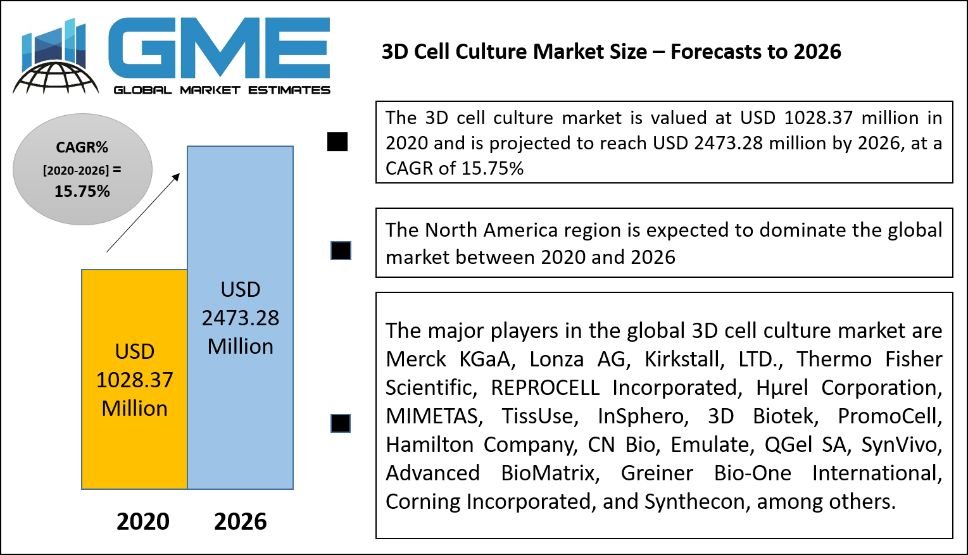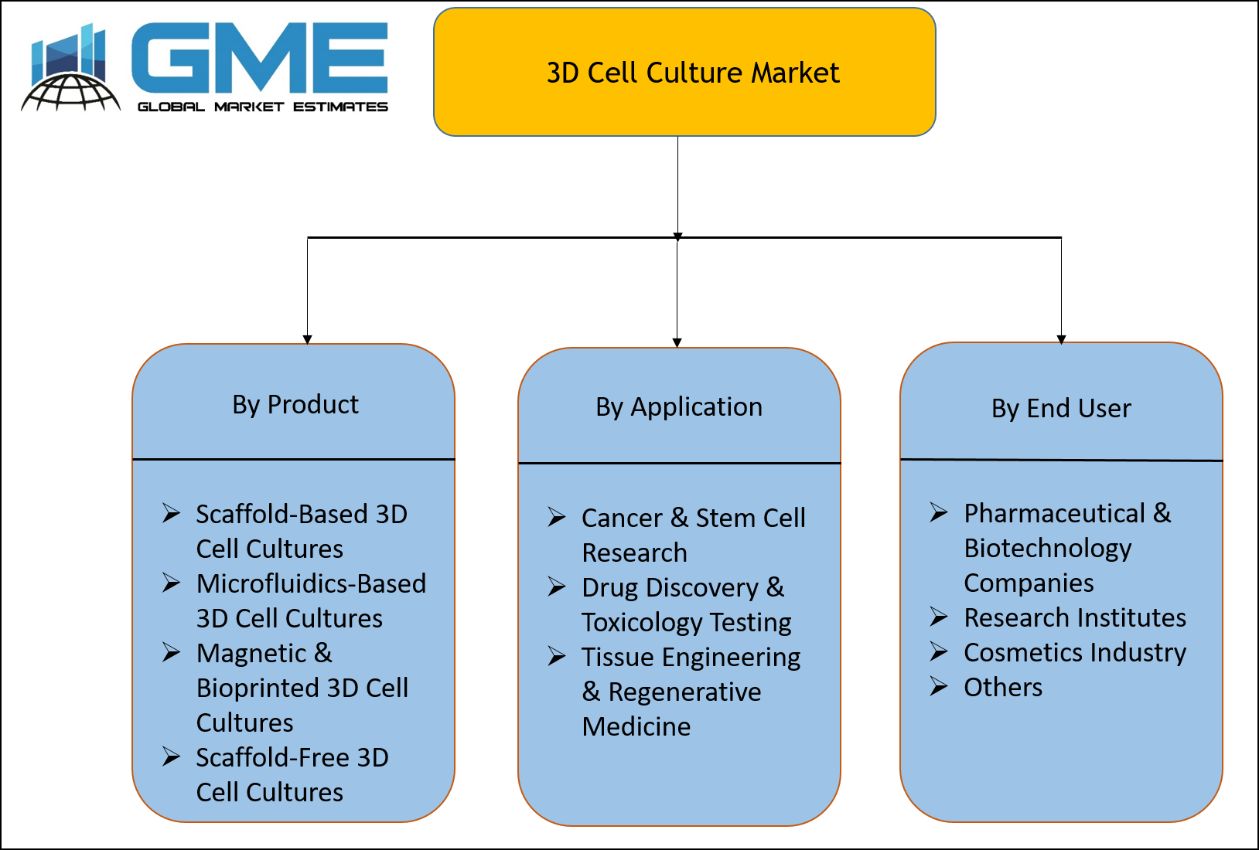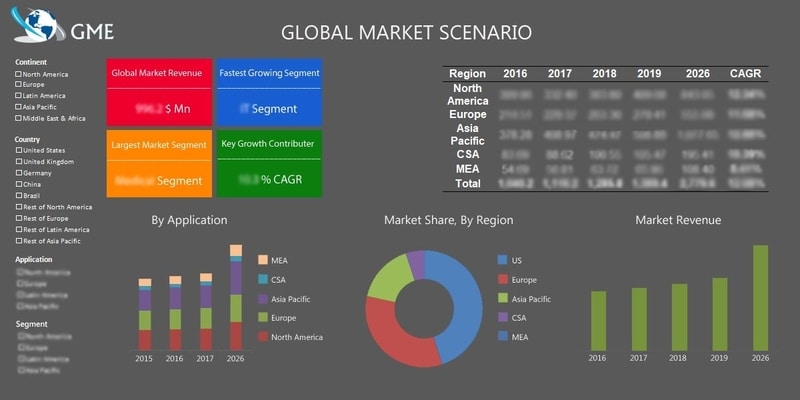
Global 3D Cell Culture Market, Size, Trends & Analysis with Covid-19 Impact - Forecasts To 2026 By Product (Scaffold-Based 3D Cell Cultures, Microfluidics-Based 3D Cell Cultures, Magnetic & Bioprinted 3D Cell Cultures, Scaffold-Free 3D Cell Cultures), By Application (Cancer & Stem Cell Research, Drug Discovery & Toxicology Testing, Tissue Engineering & Regenerative Medicine), By End-User (Pharmaceutical & Biotechnology Companies, Research Institutes, Cosmetics Industry, Others), By Region (North America, Europe, Asia Pacific and Rest of the World); and Company Market Share Analysis & Competitor Analysis
3D Cell Culture Market: Insights
The global 3D cell culture market will be dominated by a significant growth rate. An in vitro method in which cells can expand in an artificially generated environment is a 3D cell culture. Some of the vital factors that are likely to drive 3D cell culture industry growth are the growing number of companies investing in the development of 3D cell culture along with the rising emphasis on personalized medicine. The increasing demand for this technique and the introduction of 3D cell culture based on microfluidics is driving the market growth. The industry is supposed to be revolutionized by moving to 3D techniques from traditional cell culture techniques. Moreover, research project funding available for doctorate academic ventures using this technology is anticipated to augment demand for three-dimensional culture systems, resulting in industry growth. However, some of the factors that are expected to obstruct market development during the projected timeframe are high costs of research in cell biology and a lack of 3D cell-based testing facilities.

3D Cell Culture Market: By Product
Based on the analysis of the product, this market can be segregated into four segments namely; scaffold-based 3D cell cultures, magnetic & bio-printed 3D cell cultures, microfluidics-based 3D cell cultures, and scaffold-free 3D cell cultures. Amongst all the types of products, scaffold-based 3D cell cultures will be the fastest-growing segment to hold the high market share. The attributes of 3D cell culture scaffolds, such as structural rigidity and attachment point availability, have greatly influenced the preference for 3D cell cultures based on scaffolds and assured a significant share of this segment. It is further divided into solid scaffolds, hydrogels/ECM analogs, and micropatterned surfaces. Such approaches are some of the main reasons anticipated to push growth in the sector over the expected timeframe. Scaffolds are used by researchers to facilitate the organization of three-dimensional cell cultures.
3D Cell Culture Market: By Application
Based on the study of the application, this market is split up into three parts namely; cancer & stem cell research, drug discovery & toxicology testing, and tissue engineering & regenerative medicine. Cancer & stem cell research sector would be faster than the latter one in terms of value. A rigorous and representative model for in vitro drug screening is known to be the growth of immortalized, proven primary cell cultures, or cell lines in three dimensions. It provides outstanding service efficiency in terms of preventing packet loss and maintaining the most critical traffic flowing from an organization, which are some of the factors expected to influence market growth. Some of the major factors that influence the development of this application category are the growing incidence of cancer and significant support for cancer research.

3D Cell Culture Market: By End-User
Based on the study of the end-use industry, the market is broken into pharmaceutical & biotechnology companies, research institutes, and the cosmetics industry, among others. The aspect of the pharmaceutical & biotechnology companies contributes more to the global sales of the market in terms of value over the expected timeframe. This is due to the rising R&D investments in biotechnology companies, and the increasing preferences for alternate models of research over animal techniques. In comparison, over the expected timeframe, the most rising segment in the industry is a research institute.

3D Cell Culture Market: By Region
Based on the geographic region, NA, MEA, CSA, APAC, and Europe are the market divisions. The overall revenue generator in the sector is the North America region over the projected timeframe. The growth in disease incidence coupled with the infrastructure built in this area is leading to a higher market share. The growth can be due to the existence of an innovative technological system to promote the accelerated diagnosis of chronic diseases, and the region's high expenditure on healthcare. Furthermore, the European region is predicted to be the fastest-growing region over the anticipated timeline due to the growing commercialization of microfluidics-based products coupled with the increasing investment in research activities that are projected to fuel business growth.
3D Cell Culture Market Share & Competitor Analysis
The leading key players operating in this market are Merck KGaA, Lonza AG, Kirkstall, LTD., Thermo Fisher Scientific, REPROCELL Incorporated, Hµrel Corporation, MIMETAS, TissUse, InSphero, 3D Biotek, PromoCell, Hamilton Company, CN Bio, Emulate, QGel SA, SynVivo, Advanced BioMatrix, Greiner Bio-One International, Corning Incorporated, and Synthecon, among others.
Please note: This is not an exhaustive list of companies profiled in the report.
In October 2020, Merck KgaA introduced a new platform i.e. VirusExpress Lentiviral production platform that speeds the development of cell and gene therapies.
Check the Press Release on Global 3D Cell Culture Market Report
3D Cell Culture Market: By Product
3D Cell Culture Market: By Application
3D Cell Culture Market: By End-User
3D Cell Culture Market: By Region
The Global 3D Cell Culture Market has been studied from the year 2017 till 2026. However, the CAGR provided in the report is from the year 2018 to 2026. The research methodology involved three stages: Desk research, Primary research, and Analysis & Output from the entire research process.

The desk research involved a robust background study which meant referring to paid and unpaid databases to understand the market dynamics; mapping contracts from press releases; identifying the key players in the market, studying their product portfolio, competition level, annual reports/SEC filings & investor presentations; and learning the demand and supply side analysis for the 3D Cell Culture Market.

The primary research activity included telephonic conversations with more than 50 tier 1 industry consultants, distributors, and end-use product manufacturers.

Finally, based on the above thorough research process, an in-depth analysis was carried out considering the following aspects: market attractiveness, current & future market trends, market share analysis, SWOT analysis of the companies and customer analytics.

Tailor made solutions just for you
80% of our clients seek made-to-order reports. How do you want us to tailor yours?
OUR CLIENTS